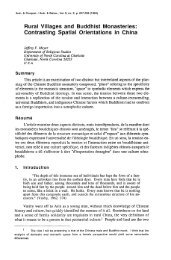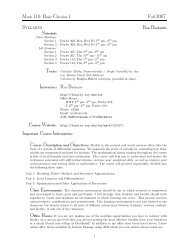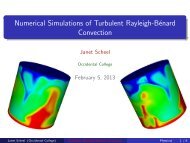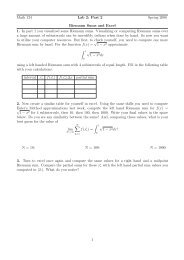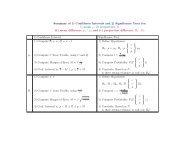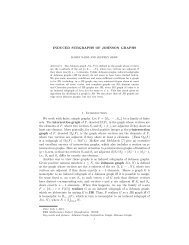Polynomial Interpolation and Extrapolation
Polynomial Interpolation and Extrapolation
Polynomial Interpolation and Extrapolation
Create successful ePaper yourself
Turn your PDF publications into a flip-book with our unique Google optimized e-Paper software.
Numerical Analysis<br />
Math 370 Spring 2009 MWF 11:30am - 12:25pm Fowler 110<br />
c○2009 Ron Buckmire<br />
http://faculty.oxy.edu/ron/math/370/09/<br />
Worksheet 14<br />
SUMMARY <strong>Polynomial</strong> <strong>Interpolation</strong> <strong>and</strong> <strong>Extrapolation</strong><br />
READING Recktenwald, pp. 521–538; Mathews & Fink, pp. 199–217<br />
<strong>Interpolation</strong><br />
Suppose one has a set of N + 1 tabulated data points (x i ,y i )(i goes from 0 to N) that one<br />
believes have been obtained very accurately.<br />
What you would like to do is obtain a functional representation which allows one to find a<br />
function f(x) which agrees with the tabulated points (often called nodes), but is also able<br />
to give reasonable values at non-tabulated points.<br />
DEFINITION : extrapolation <strong>and</strong> interpolation<br />
When the proposed x value falls in the range x 0
Math 370 Worksheet 14 Spring 2009<br />
Weierstrass Approximation Theorem<br />
If f is defined <strong>and</strong> continuous on [a,b] <strong>and</strong> ɛ>0 is given, then there exists a polynomial<br />
P (x), defined on [a,b] such that |f(x) − P (x)|
Math 370 Worksheet 14 Spring 2009<br />
EXAMPLE<br />
6. Evaluate the generic P (x) linear interpolant at x 0 <strong>and</strong> x 1 . What values do you expect?<br />
Does this happen?<br />
7. What does this tell you about properties of L k (x j )? In other words, what happens when<br />
you evaluate a Lagrange <strong>Polynomial</strong> at a node? (Is there a difference whether k = j or<br />
k ≠ j)?<br />
8. Draw a picture of L 1,0 (x) <strong>and</strong> L 1,1 (x) on the same axes below.<br />
In general Lagrange polynomials of degree n, are given by<br />
n∏ x − x i<br />
L n,k (x) =<br />
x k − x i<br />
i=0<br />
i̸=k<br />
Using a Lagrange <strong>Polynomial</strong> of degree n to interpolate a function value P (x) between n +1<br />
function values y k produces<br />
n∑<br />
P (x) = L n,k (x)y k<br />
k=1<br />
Error Formula for Lagrange <strong>Interpolation</strong><br />
The error between a function f(x) <strong>and</strong> its interpolating polynomial P (x) derived from the<br />
nodes x 0 ,x 1 ,...x n on [a,b] is given by<br />
e(x) =|f(x) − P (x)| =<br />
f (n+1) (ξ(x))<br />
∣ (n + 1)! ∣ |(x − x 0)(x − x 1 ) ···(x − x n )|<br />
where ξ(x) is in (a, b)<br />
3
Math 370 Worksheet 14 Spring 2009<br />
Groupwork<br />
Determine the second degree interpolating polynomial for the function f(x) =1/x which<br />
uses the nodes x 0 =2,x 1 =2.5 <strong>and</strong> x 2 = 4 to interpolate the value of the function at x =3.<br />
In other words, suppose we know that our data at the nodes comes from the function<br />
f(x) =1/x, use this information to generate an interpolant for f(x) <strong>and</strong> then evaluate your<br />
interpolant at x =3.<br />
(a) First write down the Lagrange polynomials of degree 2<br />
(b) Combine your answer above to form P (x)<br />
(c) Use your interpolant to approximate P (3)<br />
(d) How close is this to the actual value of f(3)? (What is the absolute error made by the<br />
interpolant?)<br />
4



